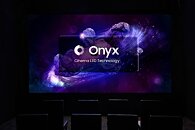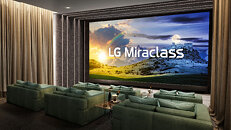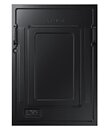T0@st
News Editor
- Joined
- Mar 7, 2023
- Messages
- 2,952 (3.81/day)
- Location
- South East, UK
| System Name | The TPU Typewriter |
|---|---|
| Processor | AMD Ryzen 5 5600 (non-X) |
| Motherboard | GIGABYTE B550M DS3H Micro ATX |
| Cooling | DeepCool AS500 |
| Memory | Kingston Fury Renegade RGB 32 GB (2 x 16 GB) DDR4-3600 CL16 |
| Video Card(s) | PowerColor Radeon RX 7800 XT 16 GB Hellhound OC |
| Storage | Samsung 980 Pro 1 TB M.2-2280 PCIe 4.0 X4 NVME SSD |
| Display(s) | Lenovo Legion Y27q-20 27" QHD IPS monitor |
| Case | GameMax Spark M-ATX (re-badged Jonsbo D30) |
| Audio Device(s) | FiiO K7 Desktop DAC/Amp + Philips Fidelio X3 headphones, or ARTTI T10 Planar IEMs |
| Power Supply | ADATA XPG CORE Reactor 650 W 80+ Gold ATX |
| Mouse | Roccat Kone Pro Air |
| Keyboard | Cooler Master MasterKeys Pro L |
| Software | Windows 10 64-bit Home Edition |
Samsung and LG are among an number of tech companies reportedly pushing for radical changes in the cinema viewing experience. In a piece published by the Hollywood Reporter last week, new behind-the-scenes information has come to light about an effort to replace the (some will say tried and true) traditional cinema theater projection system with LED walls. The vast majority of international theater chains rely on a front projection method (via a back of the booth), and very few locations have a more state-of-the-art LED display-based system in place. The Culver Theater (naturally located in Culver City, CA) is one of a hundred cinemas worldwide to possess a Samsung Onyx LED display - although the tech on show is said to be of an older standard. Industry insiders have been invited to attend demonstrations of a newer generation LED wall technology destined for cinemas in the future, and early impressions are purported to be mixed.
A cinema-based LED wall display functions in a similar way to how a modern LED-based flat screen TV works - although on a much greater massive scale - with particular benefits of the technology resulting in fantastic performance in terms of high dynamic range and peak brightness. The main downside of having a tightly packed array of large LED panels is the resultant heat output - critics of the technology state that it will be difficult to implement an adequate cooling system (through air conditioning) to tame the wall's temperature increasing properties. The power required to operate the LED panel array (plus required cooling solution) is said to be much higher than that of an old-fashioned projector's relatively modest draw from the electricity supply. An LED wall will also completely negate the traditional placement of loudspeakers behind a cinema's front-placed screen - and sound engineers will need to explore a different method of front audio channel output within the context of a next generation LED theater room.




Samsung and LG are reported to have already acquired DCI certification for their latest display technologies from the Digital Cinema Initiatives. The studio consortium had decided upon a standardized technical specification (aka technical blueprint) for direct view display late last year. Samsung touts their "Onyx" system as the "Cinema of the Future", the official blurb reads: "Sensing the need to transcend the outdated projector-based systems that have been the industry standard over the past 120 years, Samsung is prepared to play a starring role in delivering the most advanced graphics and refined production techniques and defining the "cinema of the future" with its new Cinema LED Technology called "Onyx". By bringing the visual power of LED picture quality to the big screen, Samsung Onyx offers viewers more powerful, compelling and memorable content. Inspired by the gemstone of the same name, the Samsung Onyx brand alludes to the display's ability to showcase cinematic content with true black colors. Backed by brilliant LED picture quality and an infinite contrast ratio, Samsung Onyx ensures movie content like never before."








LG Electronics announced the launch of its new LED screen brand for cinemas, Miraclass, earlier this year: "Ideal for theater operators eager to present moviegoers with new, premium services and immersive viewing experiences, LG's latest lineup of LED screens delivers realistic images with natural colors and deep blacks. The name "Miraclass"...means incredible image quality that can enhance audiences' sense of immersion. Thanks to their advanced LED technology, LG Miraclass displays help bring movies to life, improving the theater-going experience and offering new value to venue owners and operators."
LG's marketing pitch continues: "Employing self-emissive LED pixels, each LG Miraclass model delivers 24-bit color processing and outstanding contrast to give on-screen images depth and vibrancy. They also boast strong, consistent brightness with no corner dimming and produce clear, distortion-free pictures. What's more, LG Miraclass is capable of displaying 68.7 billion color variations, enabling viewers to experience movies just as their creators intended them to be seen. LG Miraclass also provides easy management for movie theater operators thanks to its intuitive software and facilitates greater space efficiency through eliminating the need for projection rooms. Additionally, the screen brightness of LG Miraclass can be adjusted across five stages, from 48 to 300 nits, offering suitability for various use scenarios - from playing 2D/3D movies to delivering content for company presentations or special ceremonies."
View at TechPowerUp Main Site | Source
A cinema-based LED wall display functions in a similar way to how a modern LED-based flat screen TV works - although on a much greater massive scale - with particular benefits of the technology resulting in fantastic performance in terms of high dynamic range and peak brightness. The main downside of having a tightly packed array of large LED panels is the resultant heat output - critics of the technology state that it will be difficult to implement an adequate cooling system (through air conditioning) to tame the wall's temperature increasing properties. The power required to operate the LED panel array (plus required cooling solution) is said to be much higher than that of an old-fashioned projector's relatively modest draw from the electricity supply. An LED wall will also completely negate the traditional placement of loudspeakers behind a cinema's front-placed screen - and sound engineers will need to explore a different method of front audio channel output within the context of a next generation LED theater room.




Samsung and LG are reported to have already acquired DCI certification for their latest display technologies from the Digital Cinema Initiatives. The studio consortium had decided upon a standardized technical specification (aka technical blueprint) for direct view display late last year. Samsung touts their "Onyx" system as the "Cinema of the Future", the official blurb reads: "Sensing the need to transcend the outdated projector-based systems that have been the industry standard over the past 120 years, Samsung is prepared to play a starring role in delivering the most advanced graphics and refined production techniques and defining the "cinema of the future" with its new Cinema LED Technology called "Onyx". By bringing the visual power of LED picture quality to the big screen, Samsung Onyx offers viewers more powerful, compelling and memorable content. Inspired by the gemstone of the same name, the Samsung Onyx brand alludes to the display's ability to showcase cinematic content with true black colors. Backed by brilliant LED picture quality and an infinite contrast ratio, Samsung Onyx ensures movie content like never before."








LG Electronics announced the launch of its new LED screen brand for cinemas, Miraclass, earlier this year: "Ideal for theater operators eager to present moviegoers with new, premium services and immersive viewing experiences, LG's latest lineup of LED screens delivers realistic images with natural colors and deep blacks. The name "Miraclass"...means incredible image quality that can enhance audiences' sense of immersion. Thanks to their advanced LED technology, LG Miraclass displays help bring movies to life, improving the theater-going experience and offering new value to venue owners and operators."
LG's marketing pitch continues: "Employing self-emissive LED pixels, each LG Miraclass model delivers 24-bit color processing and outstanding contrast to give on-screen images depth and vibrancy. They also boast strong, consistent brightness with no corner dimming and produce clear, distortion-free pictures. What's more, LG Miraclass is capable of displaying 68.7 billion color variations, enabling viewers to experience movies just as their creators intended them to be seen. LG Miraclass also provides easy management for movie theater operators thanks to its intuitive software and facilitates greater space efficiency through eliminating the need for projection rooms. Additionally, the screen brightness of LG Miraclass can be adjusted across five stages, from 48 to 300 nits, offering suitability for various use scenarios - from playing 2D/3D movies to delivering content for company presentations or special ceremonies."
View at TechPowerUp Main Site | Source






